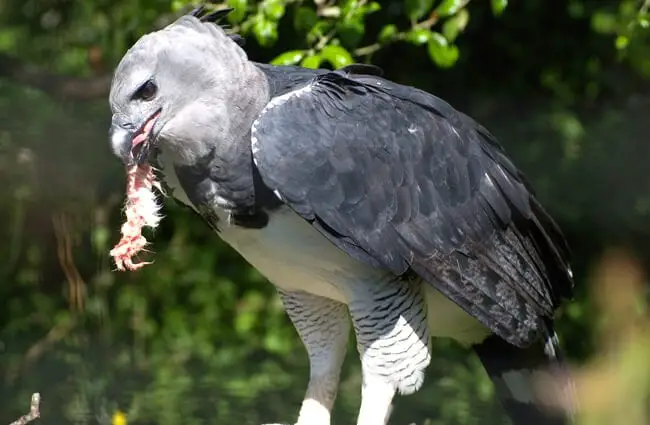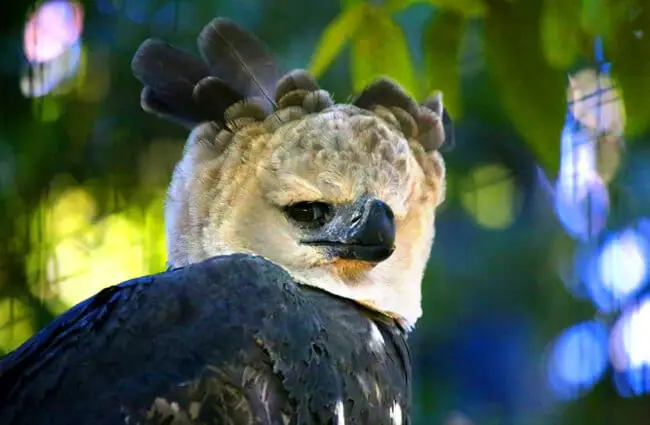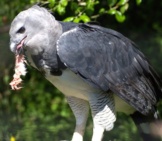Harpy eagles, also known as “American harpy eagles,” are the largest species of rainforest-dwelling raptors. These unique predators take advantage of the dense diversity of creatures in the rainforest, with impressive agility and precise eyesight. These eagles are native to Central and South American rainforests. Read on to learn about the harpy eagle.
Description of the Harpy Eagle
Harpies have slate grey feathers on their backs and wings, lighter grey colored heads, and white stomachs. Their legs are covered in white feathers with black stripes to the feet, which are yellow with large black talons. Harpies have a crown of irregular feathers atop their heads, giving them a disheveled appearance. Their tails are black, with three grey bands on top, and three white bands underneath.
Interesting Facts About the Harpy Eagle
Harpies are unique among eagles in their preferred habitat. Most birds of prey are restricted in dense forests, because prey items can simply withdraw to thicker vegetation. So how do harpies survive where other large hawks and eagles fail?
- Perching and Searching – This bird’s main method of prey capture is to hop from branch to branch, and searching. They will find a branch and use their exquisite eyesight to search for prey movement. If they find no likely candidates, they glide to the next branch. When they spot prey, like a snake, sloth, or monkey, they dive from their perch and quickly snare their next meal.
- Passive Predators – Occasionally, harpies are slightly less ambitious in their hunting. Rather than move through the forest in search of prey, they choose a comfortable perch and wait for prey to come to them. They remain on this perch for long periods, waiting until they spot a potential meal. When they snatch a prey item from a branch, they use their massive talons. Harpy eagles have the largest talons of any known bird of prey.
- Sky Soaring – Another, less common, hunting method for these eagles is flying above or within the canopy level of trees. This gives the eagle more space for flight, but fewer potential prey items. The vast majority of animals in the rainforest avoid breaking the canopy because it leaves them vulnerable to predators above.
- Chase and Grab – Finally, another uncommon hunting method for harpies is direct pursuit. Rather than waiting for prey, or quietly moving from branch to branch, these eagles will sometimes directly pursue prey. They fly through the rainforest until they spot a bird in flight, and then give chase using their agility to dive between trees and branches.
Habitat of the Harpy Eagle
Harpies are found primarily in rainforest habitats, all the way from the canopy to emergent trees, or even on the ground. Their preferred habitat is tropical lowland rainforest. They have been recorded at elevation levels up to 6,600 ft. above sea level, but are more frequently found below 3,000 ft. or so. They avoid areas that have been subject to deforestation, but can be found in more open forests, and even pasture near forest, especially when prey is scarce.
Distribution of the Harpy Eagle
These eagles are naturally found from Mexico to South America, as far south as Argentina. Unfortunately, most of the eagles in Mexico and Central America have been exterminated due to deforestation. The only area in which they are readily found in Central America is parts of Panama. The highest population density is found in Brazil.
Diet of the Harpy Eagle
The primary prey types for harpies are tree-dwelling mammals, mainly sloths and monkeys. Sloths appear to be an important part of their diet, and in some studies sloth species comprised over 70% of the prey brought to hatchlings. Monkeys are also common prey, and some species regularly taken are capuchin, saki, howler, titi, spider, and squirrel monkeys. Some other, albeit uncommon prey, include reptiles, parrots, kinkajous, coatimundis, anteaters, porcupines, opossums, and armadillos.
Harpy Eagle and Human Interaction
Habitat loss poses the greatest threat to harpies. The rainforests that they live in is cut down for logging, cattle, crop farming, and oil prospecting. These large birds are also subject to retaliation killings, as farmers have reported the killing of livestock.
Harpies hunting livestock is extremely rare in normal conditions, but in areas of disturbed forests the massive birds have been known to prey on small livestock. Luckily for the harpy there are a number of initiatives in place to preserve rainforest, and captive breeding programs have been breeding and reintroducing these birds to the wild to bolster the population.
Domestication
Harpy eagles have not been domesticated in any way.
Does the Harpy Eagle Make a Good Pet
Harpies would not make good pets. They require lots of flying space for exercise to prevent feather breakage and impacts with the sides of the enclosure. These eagles are also quite large and have powerful talons and a sharp beak that can easily tear open human skin.
Harpy Eagle Care
Eagles in zoos are provided with plenty of enclosure space for flying. They can be glove trained, and free flown by their trainers. They are commonly provided with plenty of variety in perches, both in height and size. They are also provided with lots of vegetation to replicate their natural habitat. In zoos they are fed rabbits, rats, and mice.
Behavior of the Harpy Eagle
Harpies are highly territorial, and require several square miles of rainforest to survive and reproduce. They protect their territory from other eagles, allowing them to have a consistent food source. Pairs of eagles will mate for life, and nest in the same territory. Females take most of the responsibility with raising the chicks, but males also participate. Both harpy parents will viciously defend their young from predators.
Reproduction of the Harpy Eagle
Harpies build massive nests, up to five feet across and three feet deep. Female eagles will lay two eggs, and only reproduce every two or three years. Both parents will incubate the eggs for nearly two months, and usually only one chick will hatch. Harpy chicks begin to fly at about six months old, but will remain reliant on their parents for another six to ten months. The chicks will not reach sexual maturity until they are between four and six years old.
Beliefs, Superstitions, and Phobias About the Harpy Eagle
These particular eagles are a common symbol in South American mythology and spiritualism. Harpies are known to nest in the tallest tree in the rainforest, the kapok tree. In many cultures it is considered bad luck to cut down a kapok tree because it disturbs these majestic birds. This belief actually helps keep some habitat destruction at bay.













![Red Angus Closeup of a beautiful Red Angus cowPhoto by: U.S. Department of Agriculture [pubic domain]https://creativecommons.org/licenses/by/2.0/](https://animals.net/wp-content/uploads/2020/03/Red-Angus-4-238x178.jpg)












![Red Angus Closeup of a beautiful Red Angus cowPhoto by: U.S. Department of Agriculture [pubic domain]https://creativecommons.org/licenses/by/2.0/](https://animals.net/wp-content/uploads/2020/03/Red-Angus-4-100x75.jpg)

